AP® Physics 2: Algebra-Based Cheat Sheet

- Notes
Master AP Physics 2: Algebra-Based with this cheat sheet from Examples.com. It covers key concepts and formulas in fluids, thermodynamics, circuits, optics, and more, perfect for exam preparation and quick reference.
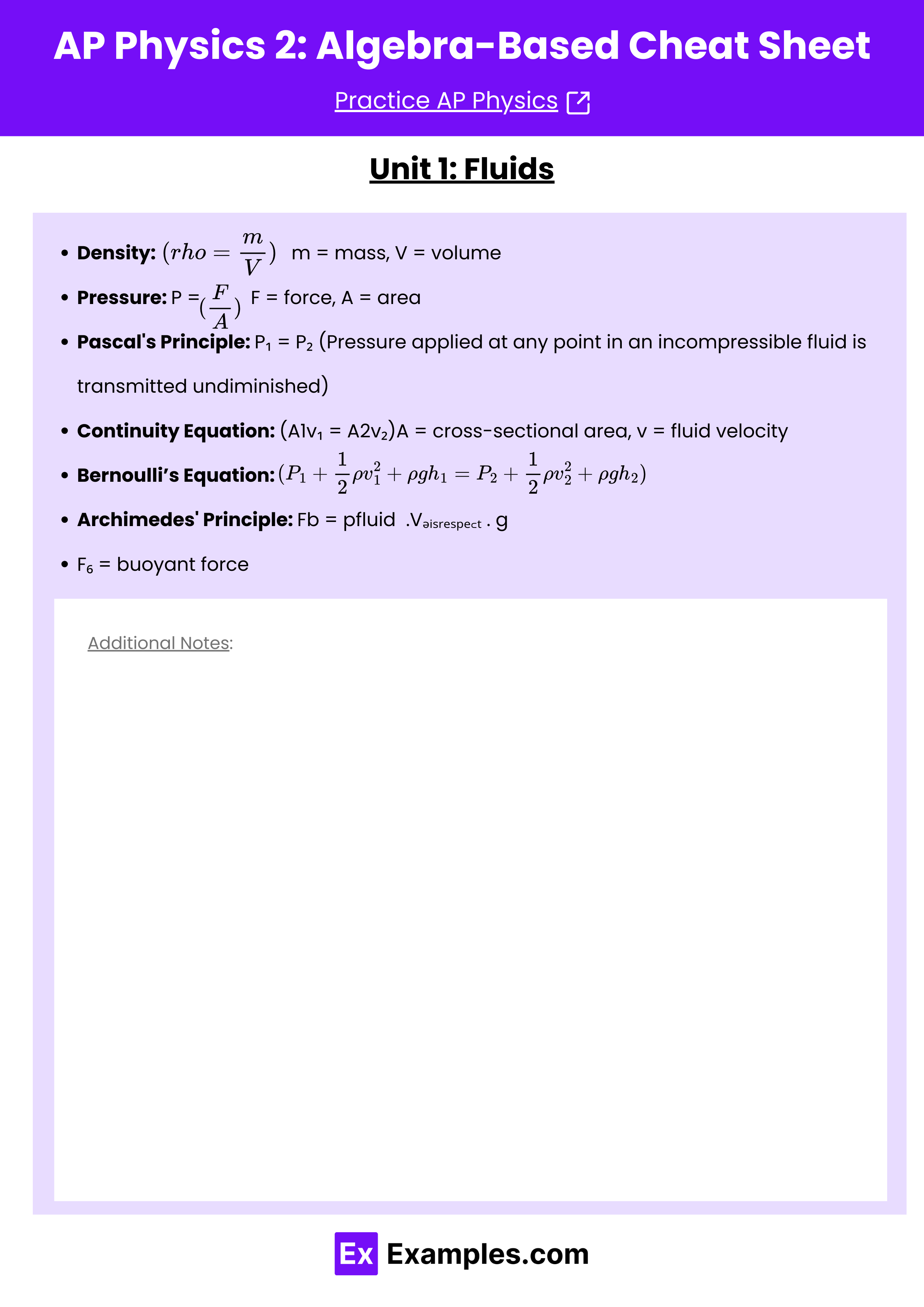
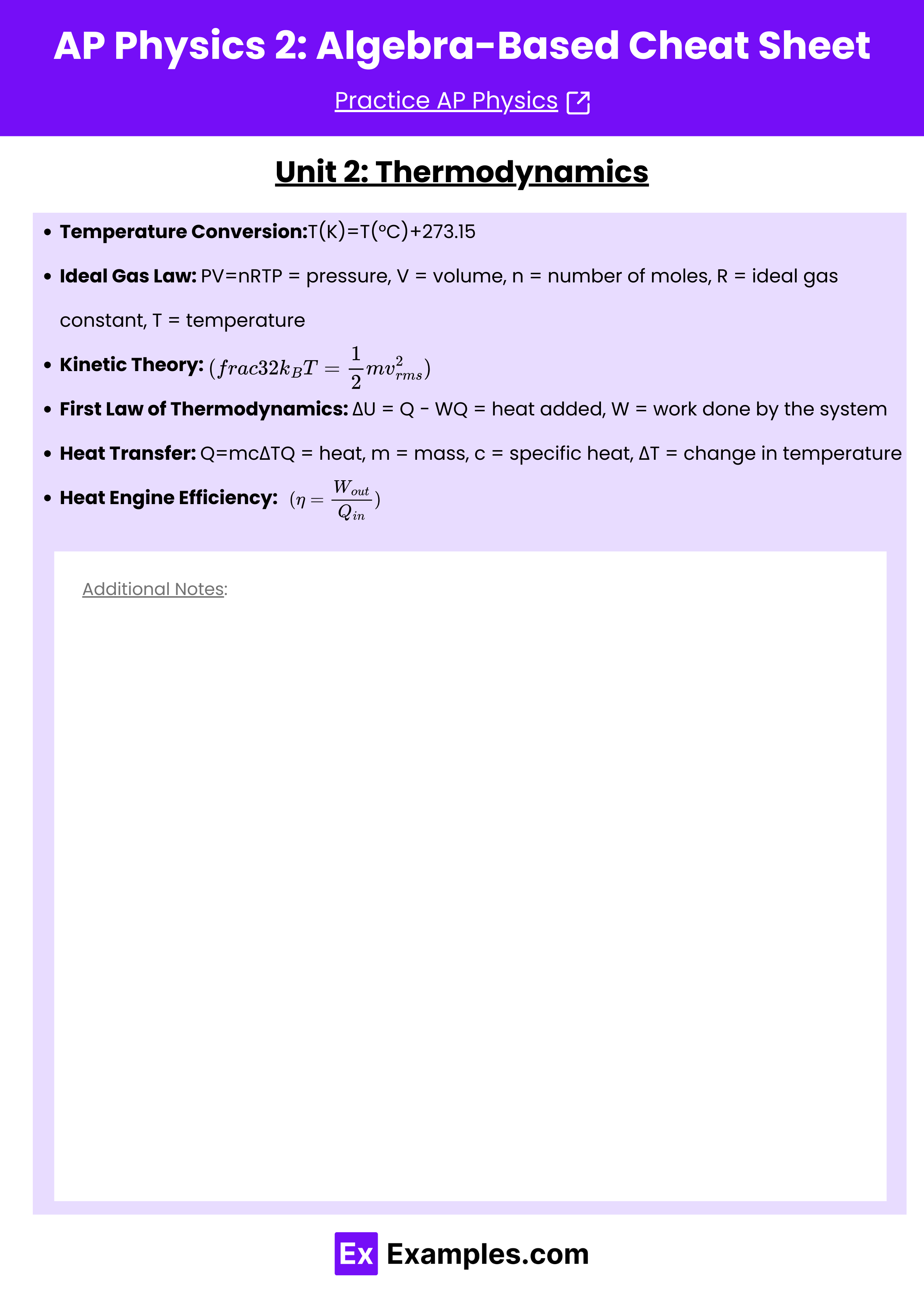
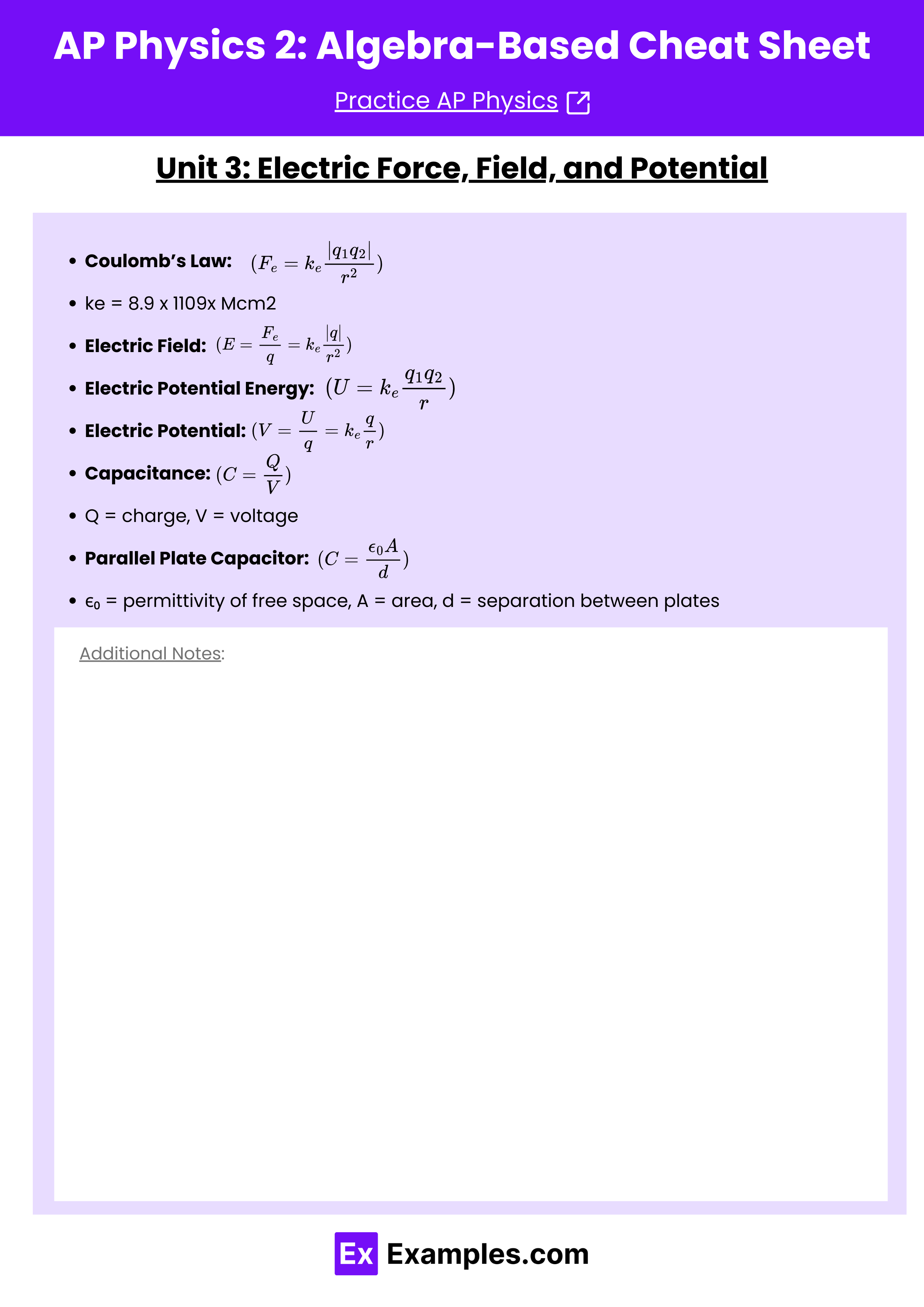
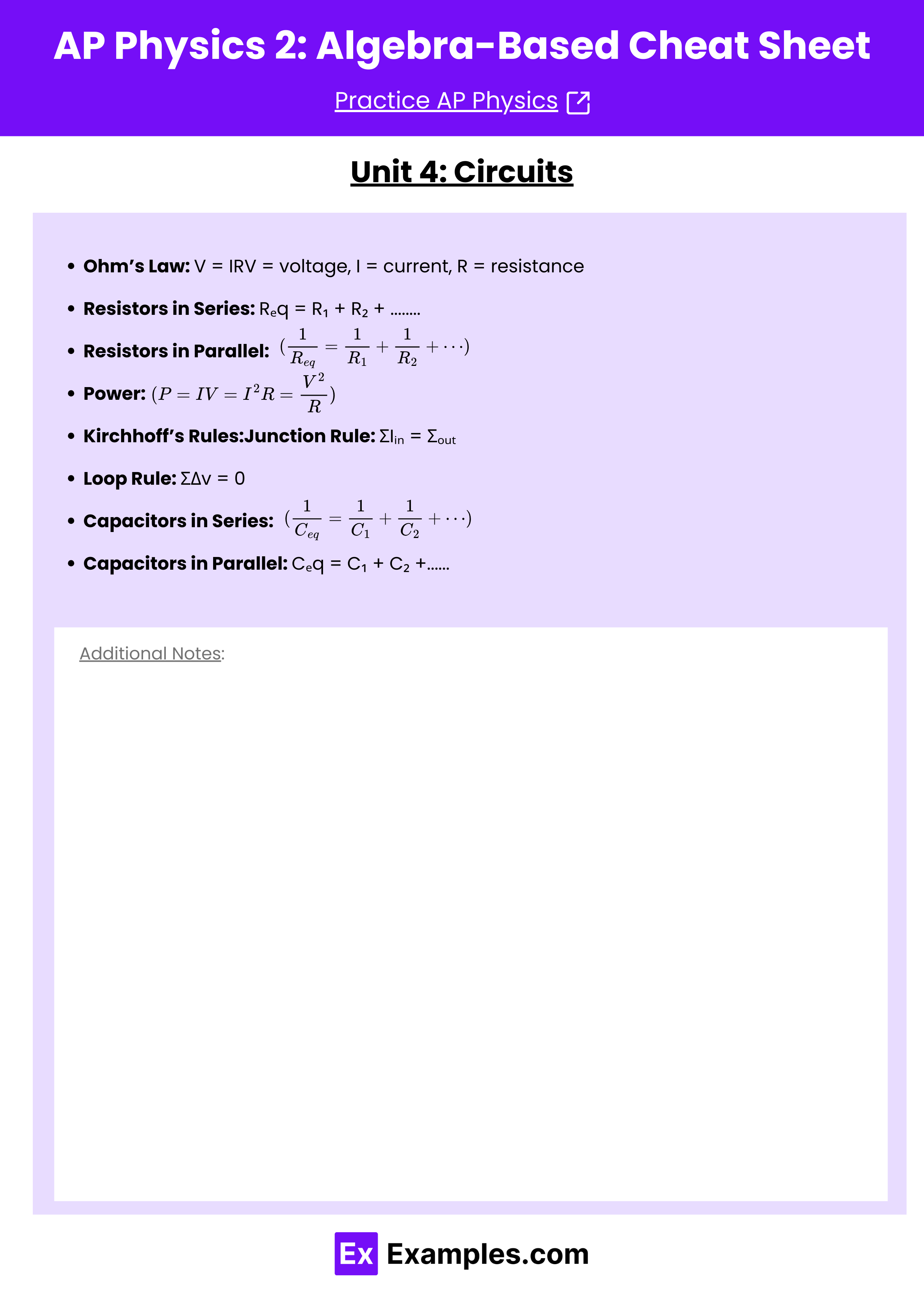
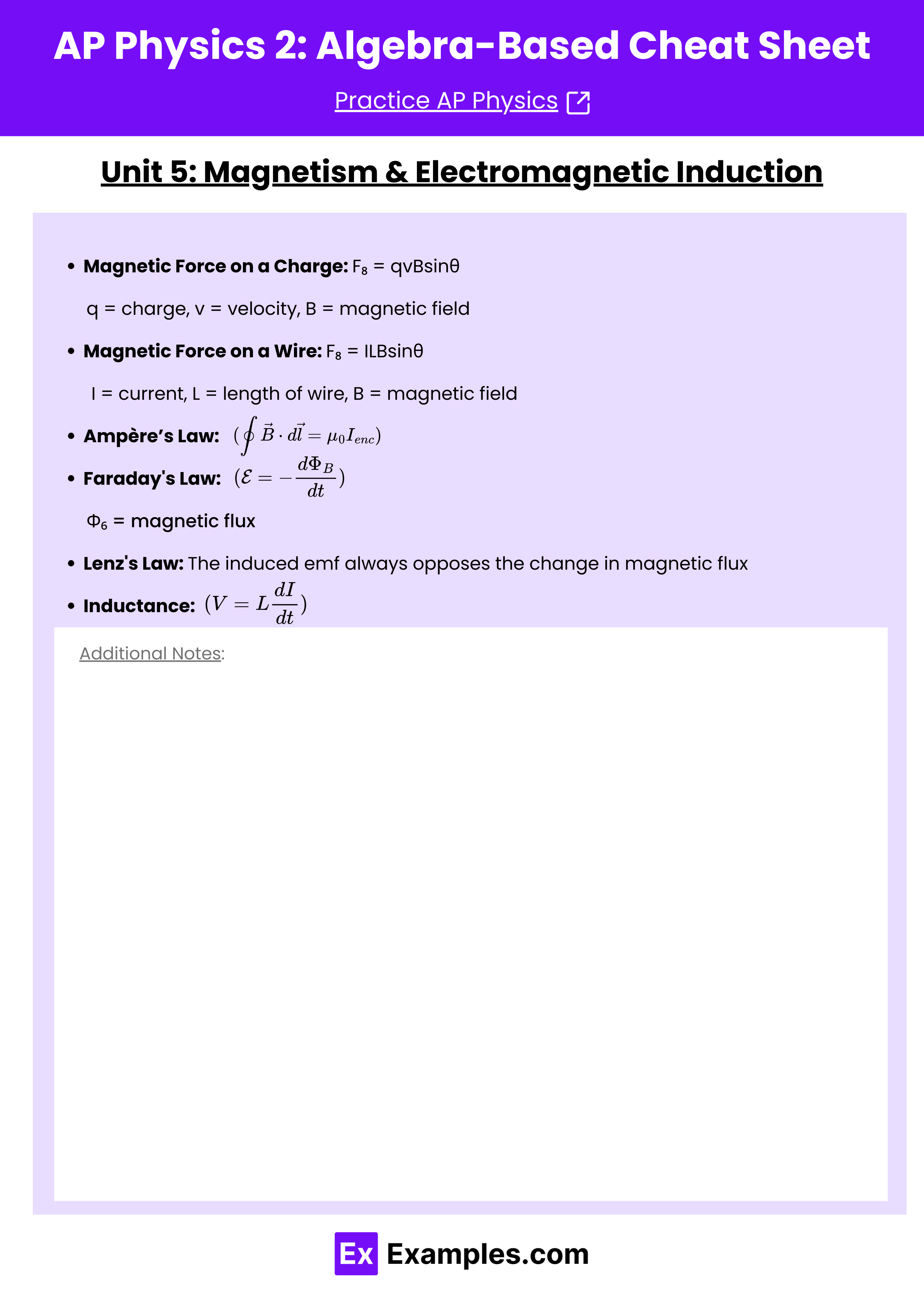
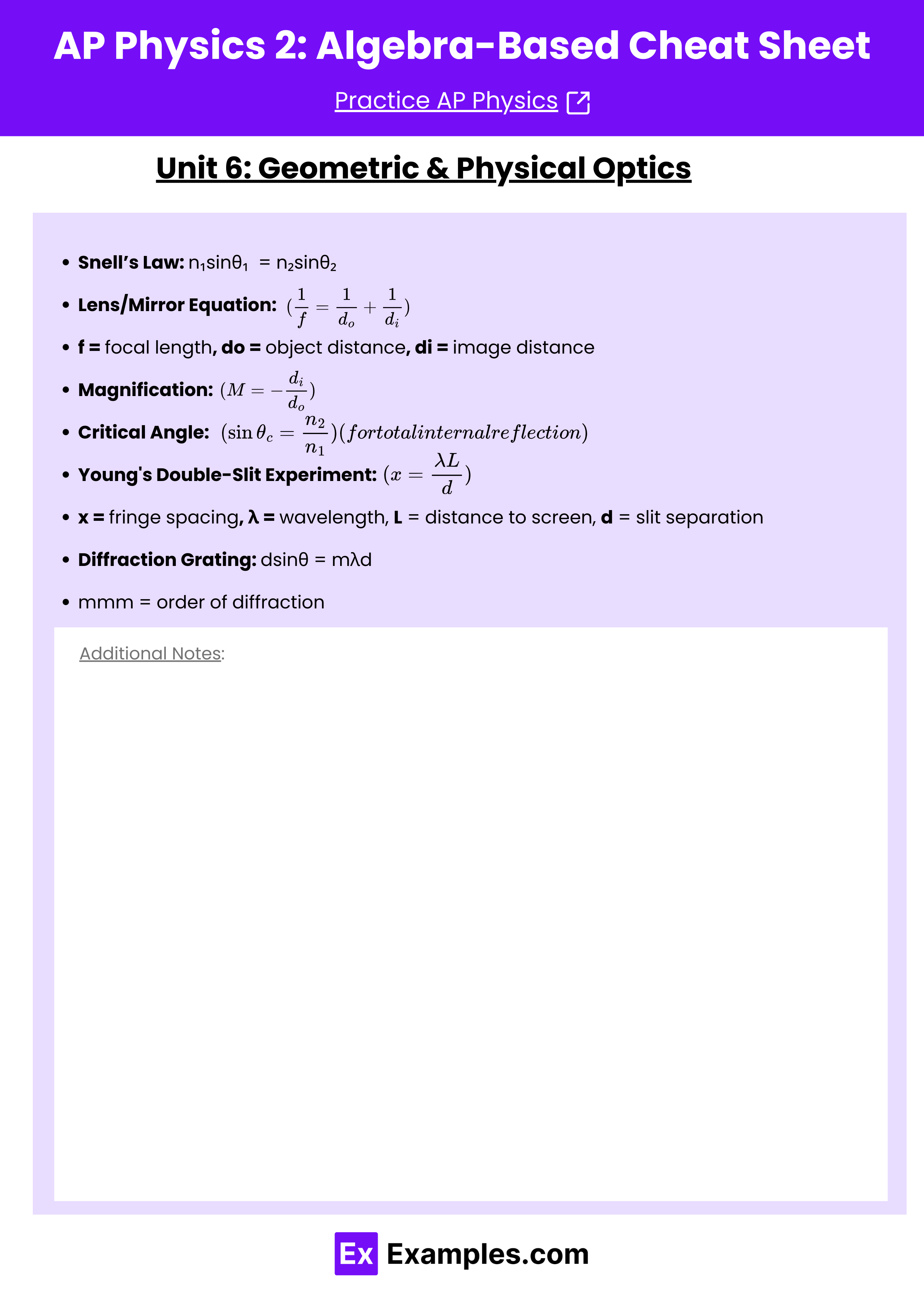

Download Physics 2 Cheat Sheet – Pdf
Unit 1: Fluids
- Density:
- m = mass, V = volume
- Pressure: P =
- F = force, A = area
- Pascal’s Principle:
(Pressure applied at any point in an incompressible fluid is transmitted undiminished)
- Continuity Equation:
- A = cross-sectional area, v = fluid velocity
- Bernoulli’s Equation:
- Archimedes’ Principle:
= buoyant force
Unit 2: Thermodynamics
- Temperature Conversion:
- T(K)=T(°C)+273.15
- Ideal Gas Law: PV=nRT
- P = pressure, V = volume, n = number of moles, R = ideal gas constant, T = temperature
- Kinetic Theory:
- First Law of Thermodynamics: ΔU = Q − W
- Q = heat added, W = work done by the system
- Heat Transfer: Q=mcΔT
- Q = heat, m = mass, c = specific heat, ΔT = change in temperature
- Heat Engine Efficiency:
Unit 3: Electric Force, Field, and Potential
- Coulomb’s Law:
- Electric Field:
- Electric Potential Energy:
- Electric Potential:
- Capacitance:
- Q = charge, V = voltage
- Parallel Plate Capacitor:
= permittivity of free space, A = area, d = separation between plates
Unit 4: Circuits
- Ohm’s Law: V = IR
- V = voltage, I = current, R = resistance
- Resistors in Series:
- Resistors in Parallel:
- Power:
- Kirchhoff’s Rules:
- Junction Rule:
- Loop Rule:
- Junction Rule:
- Capacitors in Series:
- Capacitors in Parallel:
Unit 5: Magnetism & Electromagnetic Induction
- Magnetic Force on a Charge:
- q = charge, v = velocity, B = magnetic field
- Magnetic Force on a Wire:
- I = current, L = length of wire, B = magnetic field
- Ampère’s Law:
- Faraday’s Law:
= magnetic flux
- Lenz’s Law: The induced emf always opposes the change in magnetic flux
- Inductance:
Unit 6: Geometric & Physical Optics
- Snell’s Law:
- n = refractive index
- Lens/Mirror Equation:
- f = focal length,
= object distance,
= image distance
- f = focal length,
- Magnification:
- Critical Angle:
(for total internal reflection)
- Young’s Double-Slit Experiment:
- x = fringe spacing,
= wavelength, L = distance to screen, d = slit separation
- x = fringe spacing,
- Diffraction Grating:
- mmm = order of diffraction
Unit 7: Quantum, Atomic, & Nuclear Physics
- Photon Energy:
J·s (Planck’s constant)
- Photoelectric Effect:
= work function
- ppp = momentum
FRQ Tips
- Show All Work: Even if the final answer is incorrect, partial credit can be given for correct procedures.
- Use Units: Always include units in your answers.
- Simplify Expressions: If you’re stuck, simplify the problem using symmetry or limiting cases.
- Graph Sketching: For graph-based questions, label axes, and indicate critical points like maximums, minimums, and intercepts.
- Equation Manipulation: Keep track of all variables and constants during equation manipulation to avoid mistakes.
Master AP Physics 2: Algebra-Based with this cheat sheet from Examples.com. It covers key concepts and formulas in fluids, thermodynamics, circuits, optics, and more, perfect for exam preparation and quick reference.
Free AP Physics 2: Algebra-Based Practice Test







Download Physics 2 Cheat Sheet – Pdf
Unit 1: Fluids
Density: ρ=Vm$\rho = \frac{m}{V}$
m = mass, V = volume
Pressure: P = AF$\frac{F}{A}$
F = force, A = area
Pascal's Principle: P1=P2$P₁ = P₂$ (Pressure applied at any point in an incompressible fluid is transmitted undiminished)
Continuity Equation: A1v1=A2v2$A_1v_1 = A_2v_2$
A = cross-sectional area, v = fluid velocity
Bernoulli’s Equation: P1+21ρv12+ρgh1=P2+21ρv22+ρgh2$P_1 + \frac{1}{2}\rho v_1^2 + \rho gh_1 = P_2 + \frac{1}{2}\rho v_2^2 + \rho gh_2$
Archimedes' Principle: Fb=ρfluid⋅Vdisplaced⋅g$F_b = \rho_{fluid} \cdot V_{displaced} \cdot g$
Fb$F_b$ = buoyant force
Unit 2: Thermodynamics
Temperature Conversion:
T(K)=T(°C)+273.15
Ideal Gas Law: PV=nRT
P = pressure, V = volume, n = number of moles, R = ideal gas constant, T = temperature
Kinetic Theory: 23kBT=21mvrms2$\frac{3}{2} k_B T = \frac{1}{2} mv_{rms}^2$
First Law of Thermodynamics: ΔU = Q − W
Q = heat added, W = work done by the system
Heat Transfer: Q=mcΔT
Q = heat, m = mass, c = specific heat, ΔT = change in temperature
Heat Engine Efficiency: η=QinWout$\eta = \frac{W_{out}}{Q_{in}}$
Unit 3: Electric Force, Field, and Potential
Coulomb’s Law: Fe=ker2∣q1q2∣$F_e = k_e \frac{|q_1q_2|}{r^2}$
ke=8.99×109Nm2/C2$k_e = 8.99 \times 10^9 \, \text{Nm}^2/\text{C}^2$
Electric Field: E=qFe=ker2∣q∣$E = \frac{F_e}{q} = k_e \frac{|q|}{r^2}$
Electric Potential Energy: U=kerq1q2$U = k_e \frac{q_1q_2}{r}$
Electric Potential: V=qU=kerq$V = \frac{U}{q} = k_e \frac{q}{r}$
Capacitance: C=VQ$C = \frac{Q}{V}$
Q = charge, V = voltage
Parallel Plate Capacitor: C=dϵ0A$C = \frac{\epsilon_0 A}{d}$
ϵ0$\epsilon_0$ = permittivity of free space, A = area, d = separation between plates
Unit 4: Circuits
Ohm’s Law: V = IR
V = voltage, I = current, R = resistance
Resistors in Series: Req=R1+R2+⋯$R_{eq} = R_1 + R_2 + \cdots$
Resistors in Parallel: Req1=R11+R21+⋯$\frac{1}{R_{eq}} = \frac{1}{R_1} + \frac{1}{R_2} + \cdots$
Power: P=IV=I2R=RV2$P = IV = I^2R = \frac{V^2}{R}$
Kirchhoff’s Rules:
Junction Rule: ∑Iin=∑Iout$\sum I_{in} = \sum I_{out}$
Loop Rule: ∑ΔV=0$\sum \Delta V = 0$
Capacitors in Series: Ceq1=C11+C21+⋯$\frac{1}{C_{eq}} = \frac{1}{C_1} + \frac{1}{C_2} + \cdots$
Capacitors in Parallel: Ceq=C1+C2+⋯$C_{eq} = C_1 + C_2 + \cdots$
Unit 5: Magnetism & Electromagnetic Induction
Magnetic Force on a Charge: FB=qvBsinθ$F_B = qvB \sin \theta$
q = charge, v = velocity, B = magnetic field
Magnetic Force on a Wire: FB=ILBsinθ$F_B = ILB \sin \theta$
I = current, L = length of wire, B = magnetic field
Ampère’s Law: ∮B⋅dl=μ0Ienc$\oint \vec{B} \cdot d\vec{l} = \mu_0 I_{enc}$
Faraday's Law: E=−dtdΦB$\mathcal{E} = -\frac{d\Phi_B}{dt}$
ΦB$\Phi_B$ = magnetic flux
Lenz's Law: The induced emf always opposes the change in magnetic flux
Inductance: V=LdtdI$V = L \frac{dI}{dt}$
Unit 6: Geometric & Physical Optics
Snell’s Law: n1sinθ1=n2sinθ2$n_1 \sin \theta_1 = n_2 \sin \theta_2$
n = refractive index
Lens/Mirror Equation: f1=do1+di1$\frac{1}{f} = \frac{1}{d_o} + \frac{1}{d_i}$
f = focal length, do$d_o$ = object distance, di$d_i$ = image distance
Magnification: M=−dodi$M = -\frac{d_i}{d_o}$
Critical Angle: sinθc=n1n2$\sin \theta_c = \frac{n_2}{n_1}$ (for total internal reflection)
Young's Double-Slit Experiment:
x=dλL$x = \frac{\lambda L}{d}$
x = fringe spacing, λ$\lambda$ = wavelength, L = distance to screen, d = slit separation
Diffraction Grating: dsinθ=mλd$d \sin \theta = m\lambda d$
mmm = order of diffraction
Unit 7: Quantum, Atomic, & Nuclear Physics
Photon Energy: E=hf=λhc$E = hf = \frac{hc}{\lambda}$
h=6.626×10−34$h = 6.626 \times 10^{-34}$ J·s (Planck's constant)
Photoelectric Effect: $K_ₘₐₓ =
ϕ$\phi$ = work function
de Broglie Wavelength: λ=ph$\lambda = \frac{h}{p}$
ppp = momentum
Heisenberg Uncertainty Principle: Δx⋅Δp≥4πh$\Delta x \cdot \Delta p \geq \frac{h}{4\pi}$
Radioactive Decay:
N(t)=N0e−λt$N(t) = N_0 e^{-\lambda t}$
λ=decay constant$\lambda = \text{decay constant}$
Mass-Energy Equivalence: E=mc2$E = mc^2$
FRQ Tips
Show All Work: Even if the final answer is incorrect, partial credit can be given for correct procedures.
Use Units: Always include units in your answers.
Simplify Expressions: If you're stuck, simplify the problem using symmetry or limiting cases.
Graph Sketching: For graph-based questions, label axes, and indicate critical points like maximums, minimums, and intercepts.
Equation Manipulation: Keep track of all variables and constants during equation manipulation to avoid mistakes.
